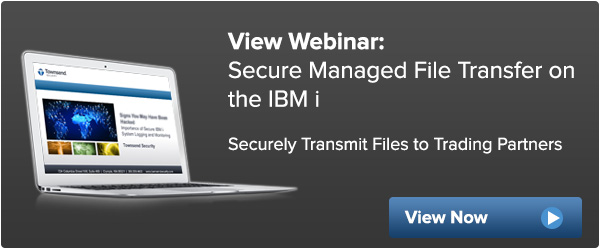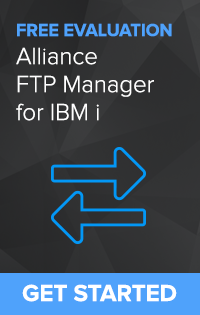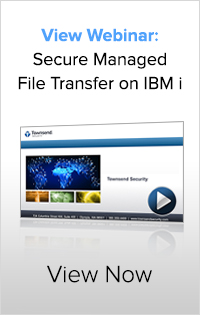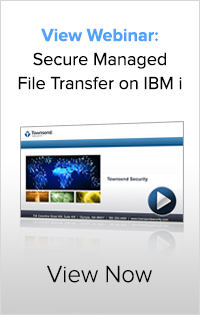Lately I’ve seen some criticism of the OpenSSH implementation on the IBM i platform which seems to imply that using a third-party implementation of the Secure Shell (SSH) file transfer application is better without the IBM no-charge licensed OpenSSH implementation. I disagree with that opinion and think there are good security and implementation reasons to stick with the IBM OpenSSH implementation.
Here are some reasons why I like OpenSSH:
OpenSSH is supported by an global open source community
Tatu Ylönen founded SSH Communications in 1995 and produced the first versions of an open source SSH implementation. Since 1999 the OpenSSH application has been maintained by the OpenBSD Project which is funded by the OpenBSD foundation and managed by Theo de Raadt. OpenSSH is available on a wide variety of operating systems including the IBM i where it is deployed as a no-charge licensed product and maintained by IBM. OpenSSH continues to be actively developed and new encryption algorithms have been added recently.
OpenSSH is a widely used by large and small organizations
By some estimates the OpenSSH implementation of the SSH protocol and applications commands a 97 percent market share for SSH implementations. This means that OpenSSH is in wide use by large and small organizations to securely manage their eCommerce needs. This also means that OpenSSH receives a lot of scrutiny by compliance and security experts. Widely deployed solutions tend to get more scrutiny from security experts, and this is true for OpenSSH.
OpenSSH is secure
No application is immune to security challenges. However, OpenBSD and the OpenSSH application in particular have a stellar record for security. With security products, deep expertise and commitment matter. OpenSSH started with security as a leading goal by its developers and it shows. Over the last few years there have been fewer than a dozen security issues, and most were unlikely to be exploited and all were patched rapidly through updates by IBM. The OpenBSD set of applications that include OpenSSH have a great record on security. If you think the IBM i platform has a good security record, take a look at OpenSSH.
IBM provides technical support for OpenSSH
We have all developed a deep appreciation for IBM’s commitment to security over the years. It is one of great values of the IBM i platform. As new vulnerabilities are discovered you need to have a reliable and timely source of patches and enhancements and IBM has stood behind this critical application. Security notifications are managed by IBM so that you know when you need to do an update. By making OpenSSH a no-charge licensed program IBM i customers get patches through the normal PTF update process. Do you know any third-party IBM i vendor with an equal commitment to notification, maintenance and patching? IBM has earned our trust through this process.
OpenSSH is PCI compliant
PCI Qualified Security Assessors (QSAs) like Coalfire, TrustWave and others recognize that a properly patched implementation of OpenSSH meets PCI Data Security Standards (PCI-DSS) compliance, and IBM also tracks OpenSSH for PCI compliance. This again reflects IBM’s and OpenBSD’s commitment to security. If you are using a third-party IBM i solution for SSH how well is it tracked by the PCI audit community?
SSH is a complex protocol
Bruce Schneier said “Complexity is the enemy of security.” SSH is a complex protocol and this means that extra care needs to be taken in its development, deployment and maintenance. No third-party SSH solution rises to the level of care taken by the OpenSSH community and by IBM. Almost every business depends on secure file transfer for daily business operations. Deploying the most secure SSH solution is a critical security step.
OpenSSH does not use OpenSSL or Java JSSE
We’ve read a lot over the last few months about security issues in OpenSSL and Java. Many IBM i customers are confused about the relationship between OpenSSH and OpenSSL. In fact, OpenSSH does not use the OpenSSL library for communications. This means that OpenSSH was not subject to the HeartBleed and other OpenSSL vulnerabilities. We are all also now painfully aware of the security issues in Java. Most browsers no longer allow Java plugins for this reason. Third-party SSH products may or may not use OpenSSL or Java for communications. If you are running a third-party IBM i SSH solution, do you know if it uses OpenSSL or Java?
Third-party SSH solutions provide no significant advantage over OpenSSH
OpenSSH is a secure, reliable, and resilient implementation of SSH for secure data transfer that is backed by IBM and a worldwide community of users and developers. Our Alliance FTP Manager solution fully integrates with the IBM i OpenSSH application for secure, automated and managed file transfer. Our solution automates the OpenSSH transfer of hundreds of thousands of file transfers every day without compromising security.
My opinion? You probably don’t need more IT risk in your life. Stick with OpenSSH for your security needs. You will be in good company.
Patrick









 In today’s environment, most organizations fall under multiple compliance regulations. If you are taking credit cards, you need to meet PCI data security standards. If you are in the health care industry, you have HIPAA and HITECH to work on. If you are in the banking industry or any financial segment, you have the Graham Leech Bliley Act (GLBA) and FFIEC requirements to meet. All of us have to deal with state and federal privacy regulations about protecting data.
In today’s environment, most organizations fall under multiple compliance regulations. If you are taking credit cards, you need to meet PCI data security standards. If you are in the health care industry, you have HIPAA and HITECH to work on. If you are in the banking industry or any financial segment, you have the Graham Leech Bliley Act (GLBA) and FFIEC requirements to meet. All of us have to deal with state and federal privacy regulations about protecting data. As more and more organizations are falling under compliance regulations, IT managers are being tasked with finding a secure Managed File Transfer solution to secure and automate data in motion with their trading partners, customers, employees and internal systems. There are a few out there, but how do you decide which is the best for your organization? I recently sat down with Patrick Townsend, Founder & CEO to learn more about the core components of a Managed File Transfer solution. Here is what he has to say:
As more and more organizations are falling under compliance regulations, IT managers are being tasked with finding a secure Managed File Transfer solution to secure and automate data in motion with their trading partners, customers, employees and internal systems. There are a few out there, but how do you decide which is the best for your organization? I recently sat down with Patrick Townsend, Founder & CEO to learn more about the core components of a Managed File Transfer solution. Here is what he has to say: